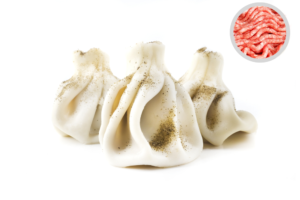Sulguni has a long history in Georgia, dating back thousands of years. The cheese was first mentioned in Georgian literature in the 12th century, and it remains a popular food today.
It is made from cow, sheep and/or goat milk. Sulguni is an important part of Georgian culture and cuisine, and it is often served at special occasions such as weddings and supra(celebration of any kind).

The cheese is also a popular ingredient in many traditional Georgian dishes, such as khachapuri (a type of cheese bread) and kinkali (dumplings filled with sulguni).
In terms of taste, Sulguni is a bit like mozzarella (buttery, creamy and light), with a texture that some describe as stretchy and gooey.
Because of its dominant fatty note, Sulguni can be used in cooking or as a table cheese.
It’s said to be particularly popular with farmers whose long, hard days in the field leave them longing for something strong, sour and cheesy.
The word Sulguni most likely comes from the Georgian word “sulghe” which means “sour”.
The word “sulghe” itself comes from the noun “sugi” which means “sourness”, “acid”, or “lactic”.
The same root may also be related to the Russian word “sukhari” (“cheese”) and the Bulgarian word “сукарите” (“sour milk”).
The making of Sulguni cheese starts with heating the milk and then leaving it to cool slightly.
This helps to coagulate the milk proteins so that they can be separated from the whey.
Once the whey has been drained off, the curds are placed in a cheesecloth and squeezed to remove any excess moisture.
The final step is to add salt and allow the cheese to age for at least two weeks.
This helps to develop the unique flavour and gives Sulguni its characteristic sour taste.
Although it can be eaten fresh, many people prefer to wait a month or two before enjoying this delicious cheese.
View this post on Instagram





